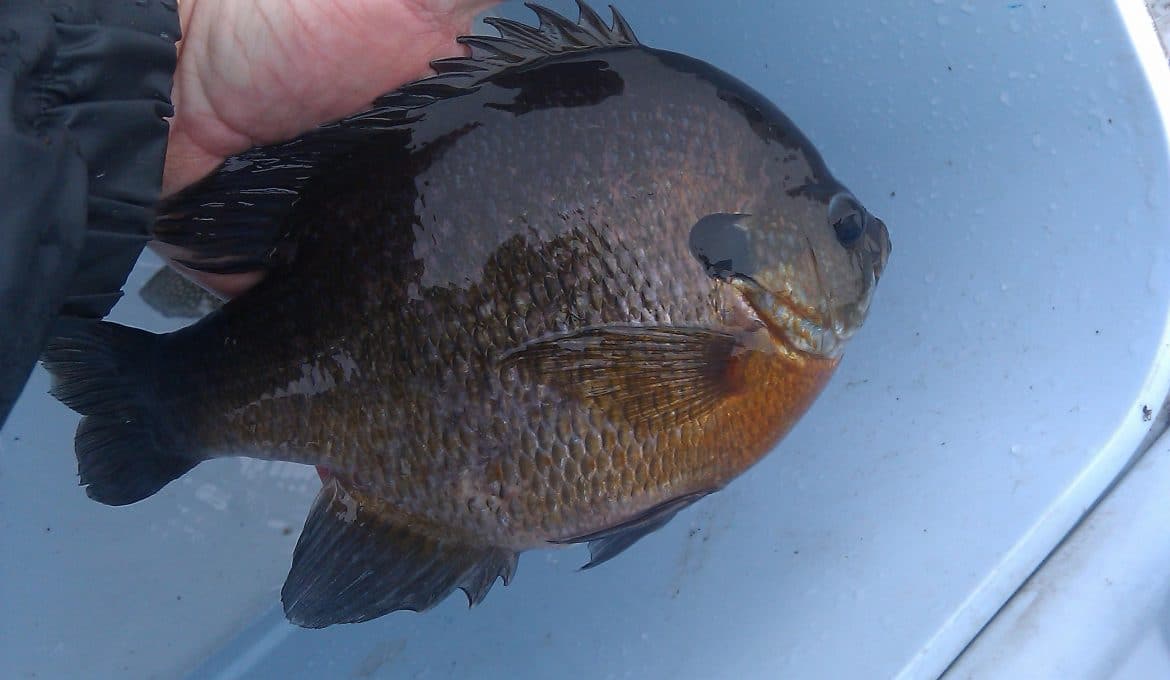Fall can be a fantastic time for bluegill fishing as they begin packing on the weight in preparation for winter. What you’re really after, though, are the big, bad boys. The bull ‘gills.
Big bluegills move and feed differently than your garden-variety school fish. Finding these larger fish can be challenging in the fall, however, because changing water temperatures can cause them to spread out.
Let’s go over some important things to consider when targeting bull ‘gills this fall.
Size Matters

It’s a good rule of thumb to increase lure or bait size in the fall. This is because baitfish are maturing and have gotten a lot bigger since spring.
If you want to catch big bluegills, consider bumping up your lure size even more so. For jigs, go to the larger end of the panfish spectrum at around 1/32 ounce. For spinners, like a Mepps, go up to size #2.
If you prefer live bait fishing, try a larger and more active crappie minnow as opposed to wax or red worms. Be prepared for the odd crappie, perch, or bass to end up on the other end of your line, though.
Have you ever caught a four-pound largemouth on an ultralight? Oh, man. But that’s a story for another time…
Stay Shallow in Early Fall

Bluegills like to return to the shallows as the water begins to cool. Here, they can happily feast on insects and small baitfish that are hunkered down in the weeds.
To avoid getting snagged, a shallow live-bait bobber rig is my preference. Make sure to attach a split shot a foot or so above your hook so everything stays put.
After Turnover, Go Deep

Compared to smaller bluegills, the large, mature fish will often head to the deeper structure after turnover occurs to seek out oxygen-rich water. As with most fish species, stick to drop-offs, weed edges, and submerged rocks or timber.
When fishing deeper water for big bluegills, a fish finder can really come in handy to locate larger congregations of fish. Compared to larger predatory fish that will cruise around, bull ‘gills will often stick cover so pinning down their location is crucial.
On that note, it often makes sense to throw the anchor down when you’ve hit a school of larger fish since they’ll be hanging around for a while.
Every Time is a Good Time

As anyone who has fished for them has probably noticed, you can fairly easily catch bluegills at any time of day. Fall time is no exception.
In fact, big ‘gills are feeding around the clock to get all fattened-up for winter. Pretty much any time you can find to go fishing is an opportunity to land some bull ‘gills.
Must-Have Fall Bluegill Gear
A Slip Bobber

Adjustable to any depth you like, slip bobbers are a necessity for bluegill fisherman. Whether they are tucked up against lily pads in three feet of water or hanging around a rock pile 30 feet down, simply slide a slip knot to your desired depth and go.
Because the design doesn’t require you to clip the bobber in place, you can easily cast these rigs are far as you like.
Small Jigs

Whether you tip them with a soft plastic or live bait, small panfish jigs (1/32 ounce or less) will be your most reliable option for fall ‘gills.
I really like the Clam Drop jig. Its bulbous shape gives it an attractive rocking action as you shake it about and some paint jobs have massive eyes to catch any hungry bluegill’s attention.
Jigging Spoons

A deadly option in deeper waters, jigging spoons offer a vertical presentation mimicking a struggling baitfish. About a foot or two off of the bottom, give them a few sharp, upward snaps followed by a brief rest.
When the bite is slow, you can tip their treble hooks with a wax worm or minnow head.
My favorite choice is the Swedish Pimple with its hallmark red tail trailer.
A Beetle Spin

When bluegills are still on the more active side, chasing baitfish in the shallows during early fall, try a Beetle Spin. These little lures are highly-effective, micro versions of a spinnerbait for panfish.
Try to keep the retrieve on the slower side to allow more wary fish to get a good look and give them an opportunity to strike.
How do you fish for fall bull ‘gills? Feel free to share your thoughts and suggestions in the comments section below.





Enjoyed this series tremendously! Earlier, you mentioned catching a 5 lb. bass on ultralight. While I never did that, I did land a 61/2 lb. Rainbow trout on a 1 weight fly rod. He broke my fly rod in half, but I landed him. Caught him on a prince nymph (that I tied myself). Just thought I’d share this I don’t know why, just thought I would.
I really enjoyed the article on bull blue gills.
Thanks a lot!!